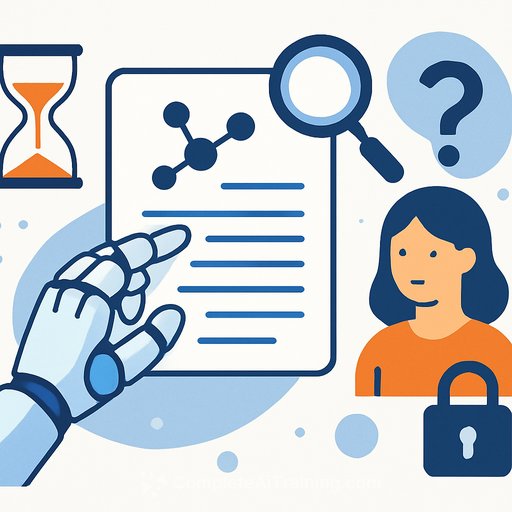Weekend reads for scientists: Publishing is a "hot mess," AI microscopy fooled experts, and social media flags retractions early
Research integrity had a busy week. From AI-generated microscopy that passes as real to retractions happening within 24 hours, the signal is clear: quality control needs to move upstream, and teams need better defense against bad incentives and bad actors.
What stood out
- Multiple image manipulation cases led to retractions, including a cluster involving a major US university.
- A paper mill operator has reached double-digit retractions, underscoring how industrialized fraud persists.
- One journal retracted a paper in less than a day after an "inadvertent mistake" - proof fast corrections are possible.
- A reviewer allegedly stole a manuscript; the publisher retracted the copycat paper after community scrutiny.
- AI can generate fake microscopy images that experts find "indistinguishable" from real data.
- Social media and community forums continue to act as early-warning systems for problematic work.
- High-profile CV "irregularities," inflated citation practices, and mass resignations keep exposing systemic incentives gone wrong.
The bigger picture
Retractions are rising and becoming more visible. COVID-related retractions alone now exceed 500, and total retractions have passed 60,000 across the literature. Post-publication review is no longer optional; it's part of a responsible workflow.
Academic publishing has been called a "hot mess." Between predatory venues, hijacked journals, paper mills, and reviewer misconduct, the burden falls on labs and departments to harden their processes. The upside: the playbook is getting clearer.
Action checklist for research teams
- Image integrity: Require raw image data at submission, archive acquisition metadata, and document processing steps. Define an explicit "no generative edits in figures" policy unless transparently labeled and justified.
- AI policy: Disclose all AI use (analysis, writing assistance, figure generation). Prohibit AI-generated images or "participants" unless the method is central to the study and clearly validated.
- Authorship and citation hygiene: Use written contribution statements, audit self-citation and citation rings, and conduct periodic CV reviews to remove "irregular" entries.
- Journal due diligence: Verify the publisher, ISSN, editorial board, indexing, and APC policies. Be on guard for hijacked sites and lookalike titles.
- Pre-submission audits: Run internal checks for statistics, image duplication, text overlap, and protocol deviations. Assign a lab "integrity champion."
- Post-publication monitoring: Track commentary on forums and social platforms, set alerts for your papers, and respond with data and transparency when questioned.
- Data availability: Share raw data and analysis pipelines when possible. Use versioned repositories and persistent identifiers to simplify verification.
- Reviewer safeguards: When submitting, prefer journals with transparent peer review policies and clear misconduct procedures.
AI: signal, risk, and practical guardrails
AI-generated microscopy can fool experts, and synthetic "participants" can skew behavioral findings. Treat any AI-derived content as high-risk unless independently validated. Document prompts, models, training data, and verification steps. If you can't reproduce it with raw inputs and code, don't publish it.
Why fast retractions matter
A 24-hour retraction shows that rapid correction is feasible. Build rapid-response protocols in your group: who assembles raw data, who communicates with editors, and how corrections are documented. Speed reduces downstream harm when errors surface.
Media, Wikipedia, and the long tail of bad information
Journalists don't always update stories after retractions, and Wikipedia entries can retain retracted citations. Consider a communications plan: public project pages, clear data links, and correction notes. Don't rely on external platforms to keep your record clean.
Equity and incentives
Findings that female faculty publish less often and in lower-impact venues should prompt local fixes: fair workload distribution, transparent credit, and mentorship with measurable outcomes. Pressure to publish "more" continues to distort behavior; push your team to value quality, reproducibility, and real-world utility.
Two resources worth bookmarking
- Crossref for metadata, Crossmark status, and retraction signals.
- PubPeer for community critiques and early flags on papers.
What to implement this quarter
- Lab policy addendum covering AI use, image handling, authorship, and preregistration.
- Centralized raw data and code archive with access controls and audit logs.
- Quarterly CV and citation review for all investigators.
- Automated alerts for your publications and keywords across major platforms.
- Preprint QA checklist with sign-off by someone not on the author list.
Why this matters now
Fraud, questionable practices, and publishing profit motives won't disappear. What you control: your lab's standards, your documentation, and your response time. Put systems in place before you submit. It pays off when scrutiny arrives.
Level up your team's AI literacy
If your group is integrating AI into analysis or writing workflows, build skills and guardrails before you ship results. A curated set of practical courses can help teams avoid common pitfalls and document methods clearly. Explore options here: Latest AI courses.
Your membership also unlocks:






